UX research: What we've learnt at Convious
1. EXPERIENCE > LEARN > IMPROVE
There is a powerful force that the world’s most successful companies have in common. It’s the secret to long term business success. It fosters progress, growth, and innovation. And it works behind the scenes every day.
So what is it? You might be asking yourself.
It is continuous improvement. That ongoing effort to keep improving in every single area of your business so you can offer customers the best version of your product that can be imagined.
However, improvement doesn’t come easy. It requires a great deal of experimentation, analysis, and learning.
1.1 And how do we learn?
As psychologist David A. Kolb realised years ago, learning and improvement come from the experience that’s followed by one’s observation, conceptualisation, and experimentation.
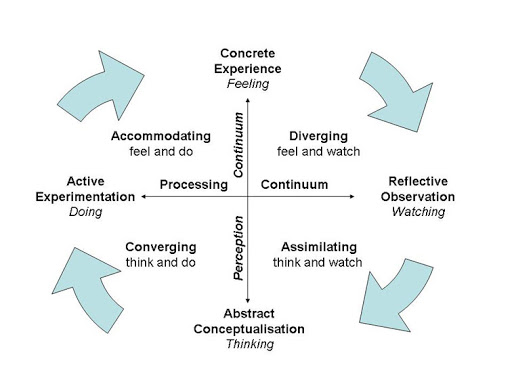
I too believe that all experiences, good or bad, bring valuable lessons. More so, if you spend some time to reflect on what happened, why it happened that way, what were the results, and what could be done differently in order to achieve a more positive outcome if a similar situation occurs.
In this sense, I am happy to say that as an ever-improving company, Convious is also learning by following this approach. How could we not? In an industry that’s devoted to the people who use our products, services and applications, research and continuous improvement are a must.
We ask questions. We observe. We gather data. And we learn everything we can about our target audience, in order to later repetitively test our work throughout the User Experience process. This allows us to identify and confirm (or not) our assumptions, find common points across our target audience, and recognise with greater clarity their needs, goals, and behaviours. Overall, research guides us on the right path by providing a better understanding and gives us the chance to improve at what we do.
So earlier this year, together with our product team, we decided to explore and observe our users and their behaviour from a fresh point of view, creating space for unknown innovations.
And we want to share what we learnt from conducting this UX research with you.
Because like I said before, yes, we learn from experience, but it doesn’t always have to be our own.
2. WHERE DO I START?
Start questioning stuff. Start with an open mind.
It’s rather hard to start there when you have been working with the same product for a while, talked with plenty of similar customers and got used to the current product’s interface. You know your product inside out, better than anyone else, but you might have been looking at it from the same angle for too long.
Be ready to question it, to change it, and to discover unexpected results. Your users might not be seeing it (or using it) the way you think they do.
Therefore, to begin with, we agreed on what were the most important general rules before conducting this research:
- Questioning current beliefs about our users
- Being truly open and accepting of whatever will fly towards us as a
result of the research, and well, this is the tough one… - Be ready for some honest criticism 🤷🏽♀️
We made these rules our golden guidelines throughout the whole research, no matter the tools chosen to conduct it afterwards.
We then agreed on a few simple yet clear methods to be used based on our budget, planned deadlines, and desired outcomes. Our goal for this particular research was to update our user journeys based on the new personas we defined thanks to the information gathered in the process.
So think about what part of your product you are seeking to improve, and then define a clear goal for your research. This will be really helpful when choosing and designing the right methods and resources to conduct it.
3. CHOOSING THE RIGHT RESEARCH METHOD
3.1 The survey
3.1.1 Gathering input.
This was our main chosen method to gather the information we needed, but it doesn’t necessarily have to be yours. Observation, Card Sorts, Interviews, Usability Tests, Tree Tests, A/B Tests…. there is a lot to choose from. Just make sure you go with the set of techniques that will allow you to collect valuable information so you can improve your product and make it more user-centred.
Before you design your survey there is a number of things you should keep in mind:
- Who is your audience? What is the minimum sample of people you need to reach in order to have conclusive results? Is there any way you can incentivise and motivate participation?
- How will you distribute it? Through which channels? Are they adequate for the audience you are targeting?
- Are you looking for quantitative or qualitative information? Sometimes a combination of both can give you more insight.
- Which fields are you going to make mandatory and which optional?
- Will it be best to use closed or open-ended questions?
Our publicly-shared survey, for instance, consisted of 12 questions: only 4 of them were open-ended, while the rest had a set of options to choose from. In total it took our participants around 10 minutes to complete the full questionnaire. We figured this was a reasonable time-frame for the sample we were targeting, which were mostly inhabitants of busy cities. Therefore, we kept our questions straight to the point and made the survey as concise as possible. On top of that, we tried to motivate participants by giving them the chance to join the one-time lottery where 3 Amazon gift-cards were given away, which helped us increase the number of respondents and gather very valuable input in less than two weeks. Lastly, by spreading the survey via a few social media channels and publicly announcing the lottery winners, we got a huge reach and a great branding for Convious and its product.
So yes, designing a survey can be pretty easy. But designing a useful and valuable survey that adjusts to your needs and audience? Well… not so much. It requires time, money, and lots of fore-hand planning.
However, if you do it right, you will have enough valuable information to learn from. Which will take you to the end-goal: improvement.
Thanks to our research we found out more about our user’s fears, pain points and expectations of the online buying process, such as speed, avoiding queues, simplicity of the process, to be able to buy in advance and get lower prices…
We also learnt that people are sensitive to:
- when it comes to safety when buying online
- additional fees unannounced at the end of their buying experience
- unknown payment methods
- way too long and complex purchasing processes
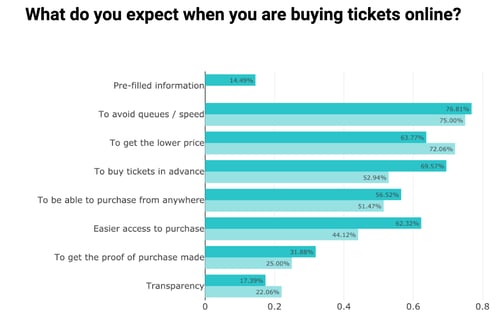
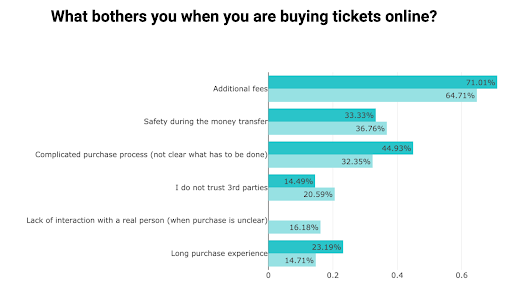
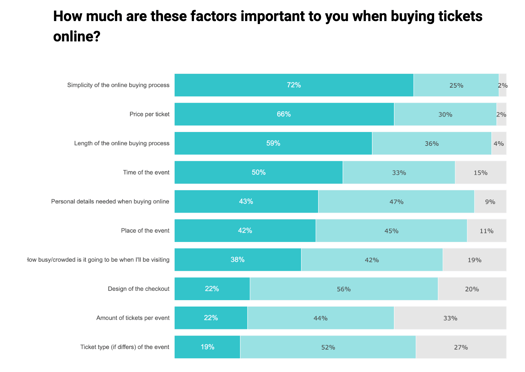
In some cases, we also realised having open fields for feedback and suggestions led to participants sharing great (and fun!) ideas. When we asked about the perfect buying process, one respondent even explained in great detail how in a perfect world he would love to be able to make an online purchase just with two clicks while (wait for it…) drinking a beer!
And let’s be honest, who wouldn’t want to have a buying experience as smooth as that?!
3.1.2 The output: Creating Personas and adjusting User Journeys.
From the information we gathered using a simple 12 question survey, we were already able to define different groups of users based on their behavioural tendencies and adjust our offered solutions accordingly. By tracking and paying attention to our user’s behaviour we were able to identify their buying habits, how our buying process makes them feel, what are their expectations… and we got to know them much better overall. This way, we created an opportunity to adjust and personalise our product and buying experience to meet our different buyer persona’s needs.
You can learn more about how personalisation can help you boost your online sales and improve your user’s online experience here:
- How Personalization Helps Companies Boost Their Online Sales
When digging into our research’s findings we identified two different sets of people. These user groups became two different and clearly defined personas: Bob and Mary.

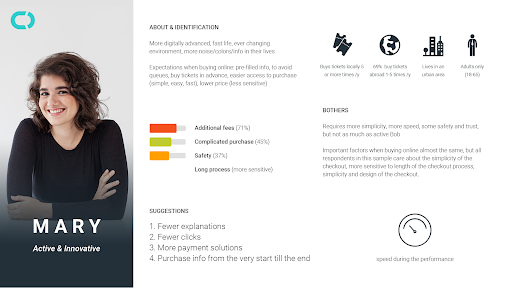
What followed naturally was our desire to get in the shoes of Bob and Mary in order to truly understand their joys and struggles. So we started reviewing step by step the already existing user journeys of our product as if we were Bob and Mary (with their specific lifestyles, daily struggles, and needs, in some random real-life situations).
This way we noticed and listed all the strengths and shortcomings of our offered solution back then. From that point on, we could already start drafting and designing new and improved user interactions for Convious’ system, as well as opening a discussion about which ones were perceived as most intuitive and valuable and on the contrary, which ones had issues we should solve.
3.2 Usability Tests
After we had agreed on the best updated and improved user flows, our clickable prototypes were ready to be built.
However, we had a feeling it might not be enough just yet, and that we might have missed a few pieces along the way as our eyes got used to the new designs and flows already.
That’s when we came up with the idea of running a few Usability Tests.
“Usability testing consists of a method where potential or current users of a product are asked to complete a set of specific tasks, in order to observe their behaviour and determine the usability of the product in question”
This way, we were able to test our prototypes on real people with an external vision of our product, just to make sure we had succeeded in truly solving the previously discovered problems for our personas. The question was… where could we find these people that would be our “Bobs” and “Maries”?
Well, thankfully, through the previously mentioned survey, we acquired many contacts from around the globe who had already shown interest in exploring the topic, so we simply reached out to them saying: “Hey, thank you once again for participating in our research! Would you spend a few more minutes with us on this topic?”, and many of them happened to be interested in further contributing.
So we later scheduled a few Usability Tests with them online and prepared related open-ended questions.
Here are some of the points that we have realised to be important when conducting these tests:
- Inform the participants about the usage of the gathered input (how you will use the information you gather from them and who is going to see it)
- Ask if the test can be recorded and shared with the team (there is a bigger chance of spotting and noticing important key points when more people observe)
- Express gratitude for the time they’ve given you and explain how it’s valuable for the usability test.
- Give context. Explain the backstory of the main goal that this user needs to achieve.
- Make sure everyone understands that there’s no rights and wrongs. All questions should be welcomed and any outcome of the experience will be valuable while investigating.
- Ask your participants to explore their thoughts, feelings, expectations and most importantly, to express them openly right away while going through the offered prototype.
- Thank them again for their input and the value they have brought to your research at the end of the test.
4. TEAMWORK: BRINGING EVERYONE INTO THE CONVERSATION.
After conducting the survey and usability tests, we proceeded to review the recordings with the product team, summarised the findings, and had some constructive discussions, until we finally agreed on the newest improved solutions we were going to implement.
We then invited every member at Convious to join a call where the findings of the research were shared, as well as the latest prototypes that we agreed on developing.
During this online meeting, our colleagues were raising extremely valuable questions, as well as providing insights, vision and feedback from perspectives that we hadn’t taken into account before. Therefore, I cannot highlight enough the importance of bringing everyone into the conversation.
Indeed, I would say this is one of the most valuable lessons we took away from this research: that by presenting findings openly and to people from different areas within the organisation, not only we gained new perspectives and ideas for future improvements, but we also strengthened our team spirit by keeping everyone on the same page of what’s being planned, towards which direction we are moving and most importantly, why.
These are just some of the things we’ve learnt by conducting our research here at Convious. However, there’s always room for improvement and much more to learn, not only from future research, but also from each other. So if you have taken part in any research directed towards product improvement why not share your thoughts and experiences so we can all keep on improving together?
Long live teamwork, long live research-driven decisions!
Convious, the leading eCommerce platform for the experience economy, launched this week their Mobile Food Ordering solution. With Convious’ Mobile Food Ordering technology, visitors can now.